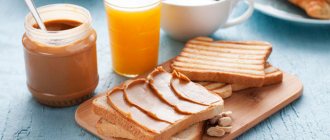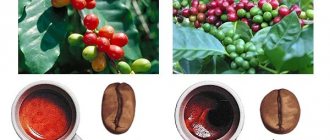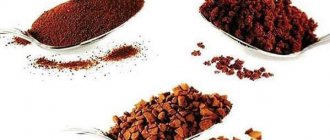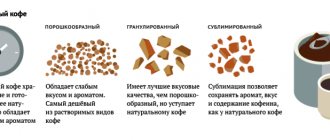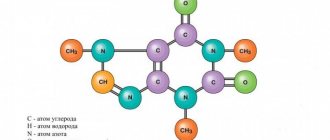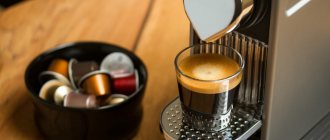What does the drink consist of?
According to manufacturers, this type of coffee contains coffee beans, milk or cream, and sugar. True, the shelf life of natural dairy products is quite short. Therefore, instead of them, vegetable cream is used containing the following components:
- coconut or palm oil;
- glucose syrup;
- acidity regulators;
- milk protein;
- flavor enhancers;
- emulsifiers;
- stabilizers.
The most expensive component is the coffee fruit. Naturally, manufacturers save on them in every possible way and use the cheapest robusta beans. Often they are completely replaced with barley grains, acorns or chicory.
Often, excessive amounts of granulated sugar are added to the bags. Due to this, it is possible to hide the taste of a low-quality product. The drink turns out to be very sweet and cloying.
The composition may also include additives such as liqueur, coconut, chocolate or caramel. These components are also created artificially. They have nothing to do with natural products.
In 100 g of drink, the protein content is 2.35 g, fat 10.4 g, and carbohydrates 69.72 g. The calorie content of 3 in 1 coffee is quite large - 358.25 kcal.
Composition of the drink
It would do well for lovers of surrogate products to know that the composition of 3 in 1 coffee - Nescafe or Maccoffee - includes the following components:
- A glucose-based syrup that sharply increases blood sugar levels, causing the pancreas to actively produce digestive juices and insulin. After several years of regular consumption of 3-in-1 coffee, the caloric content of which is excessively high in 1 bag, you can develop pancreatitis or cholecystitis.
- Palm oil, which is beneficial only in its raw form and only to healthy people leading an active lifestyle. Refined, which is present in the 3 in 1 composition, is poorly digested and deposited inside the vessels.
- A milk protein of artificial origin, which caused a scandal in China and several directors of companies producing this product were executed because children died. Melamine was added to milk, supposedly to improve its characteristics. The substance can cause kidney failure.
- Acidity regulators based on potassium phosphate are used to maintain the color of the powder and promote its friability.
- Stabilizers and emulsifiers - sodium citrate, sodium polyphosphate and other chemical compounds - are not very toxic, but only in acceptable quantities. The problem is that few manufacturers adhere to these standards.
As a result of chemical analysis, you can think about whether three-in-one coffee in bags is harmful or not, which brand to choose to maintain health, how many times a day to drink.
Dry cream - what is it?
Until a certain point, manufacturers used natural milk powder. But soon its use became unprofitable, since milk protein quickly deteriorates and cannot be stored for a long time. It was replaced with dry palm powder, which immediately affected the taste of the drink as a whole.
The advantage is only for manufacturers, since such a product is cheaper. Buyers only experience harm when drinking 3-in-1 coffee.
The calorie content of one bag of 3 in 1 coffee when using dry vegetable creamer is less than when adding milk from any manufacturer - McCoffee, Jacobs, Nescafe, Nestlé.
Instant coffee - how it is produced
To understand the composition of McCoffee or Nescafe 3 in 1 bags, you need to know the technology for producing instant coffee. First, the ground grains are brewed with boiling water on an industrial scale, then all the liquid is removed, and the remaining substances are formed into granules or remain in powder form. It is clear that with this technology, few aromatic substances reach the consumer; the taste has to be enhanced by adding chemicals.
An interesting fact is that some bags do not contain coffee at all - it is replaced with nut kernels, acorns, chestnuts, and chicory root. Usually, “coffee” is written on the label, and the actual composition of the powder is written on the back in small print.
There is no need to talk about any vigor after drinking the drink. People who are contraindicated for caffeine can drink this drink. Those who want to buy coffee should read the ingredients so as not to feel deceived.
Supplements – natural or not
3-in-1 coffee bags often contain various additives - caramel, rum, cognac, nutmeg, vanilla. Studies conducted in chemical laboratories gave a clear answer - the additives are not real. This marketing ploy was necessary to increase sales, and chemicals were added to the composition.
Calorie content of coffee with milk or cream
If you prefer to reduce the bitterness of caffeine with milk or cream, then this component will add calories to your coffee.
The number of calories in milk depends on its fat content.
If milk has 3.5 {ff3290b889689e93688dc8b73290c9f83eb66bc381a1eb5e1a8ac1930feb8ef5} fat content, then 100 g. contains about 63 kcal. When the fat content is reduced to 0.5 {ff3290b889689e93688dc8b73290c9f83eb66bc381a1eb5e1a8ac1930feb8ef5} the number of calories is reduced by 2 times.
Much fattier than cream. In 100 gr. at 35{ff3290b889689e93688dc8b73290c9f83eb66bc381a1eb5e1a8ac1930feb8ef5} fat content contains up to 340 kcal. The same amount is contained in whipped cream.
Condensed milk has a calorie content of about 24 kcal.
Benefit or harm
If you drink this drink occasionally, no harm will be done to the body. True, the sublimate will not bring any benefit either. Positive changes can only be observed if the composition contains natural grains. Thanks to their presence, you will be able to get a boost of energy.
Three-in-one coffee will cause harm if consumed systematically. This may cause the following problems:
- increase in body weight. Due to high sugar content;
- disruption of the nervous system, gastrointestinal tract;
- removal of calcium from the body;
- heart problems.
Separately, it should be said about the dangers of this sublimate during pregnancy. It is not advisable for pregnant women to drink coffee at all.
Caffeine can cause miscarriage and provoke abnormalities in the development of the child. Expectant mothers should completely avoid the 3-in-1 drink. It contains a lot of chemicals and a lot of sugar. If you really can’t give up coffee, it is recommended to give preference to a natural product.
It is possible to reduce the negative impact of a coffee drink. In this case, you should adhere to the following recommendations:
- add a little natural milk to the composition. Thanks to this, it will be possible to compensate for the lack of calcium;
- Avoid using sublimate on an empty stomach. It is best to drink it half an hour after eating;
- after each cup of drink, drink at least a glass of plain water;
- do not abuse coffee products. It is strictly forbidden to drink it too often.
Types of coffee-based drinks
Let's consider the calorie content of such favorite drinks as latte, cappuccino and iced glass.
A classic cappuccino consists of one third coffee. Another third of the drink is hot milk and the remaining part is milk foam.
The calorie content of a two hundred gram cup of cappuccino will be approximately 60 kcal.
A latte also consists of espresso coffee and milk, but the ratio of ingredients in this drink is different. For one part coffee you need to take three parts frothed milk.
The calorie content of 200 g of latte is therefore slightly higher than a cappuccino and amounts to 64 kcal.
Glasse is perhaps the most high-calorie milk-containing coffee drink. They prefer to drink it in the summer, since the ice cream is based on espresso and ice cream.
The calorie content of a cup of classic glass is more than 150 kcal.
To date, scientists have come to a consensus about the benefits of coffee.
It is an undeniable fact that to cause the least harm to the body, it is better to use natural ingredients.
Cooking rules
Coffee in 3-in-1 bags has gained great popularity due to its ease of preparation. You need to do the following:
- Open the package and pour its contents into a cup.
- Pour boiling water into the container.
- Stir the resulting liquid with a spoon.
After this, the coffee is ready to drink. Such actions can be performed in any conditions where there is boiling water. Therefore, 3-in-1 bags are often taken to work or on a trip.
Three-in-one coffee is very popular in all corners of the planet. Its main advantage is the speed and ease of preparation. True, no more positive qualities are noted. The product contains many chemical elements, and coffee beans are often completely absent. True, sublimate lovers are not embarrassed by this fact; they continue to drink it day after day. After all, it only takes a few seconds to prepare, but the end result is a tasty, sweet drink.
Popular manufacturers
“3 in 1” coffee sticks are produced by both large brands and very little-known ones. In their assortment you can find instant coffee with different flavoring additives. The most popular manufacturers include:
- Nescafe. Made from Arabica beans. The company produces drinks of different strengths: “Classic”, “Strong” and “Soft”. "Caramel" was recently released. Vegetable cream is used. The share of sugar is 60%. There is a sweetener - sodium cyclomate. It is noteworthy that Nescafe has a low content of trans fats.
- Jacobs. “3 in 1” sticks are available in different flavors – “Classic”, “Strong”, “Soft”. New is the Jacobs 3 in 1 Monarch. The package no longer contains powder, but whole granules with vegetable cream. Sugar – 40%. Some trans fats. There is a sweetener - acesulfame potassium.
- "Petrovskaya Sloboda" Many consumers choose Russian-made products. The assortment includes different flavors of the drink in bags - “Classic”, “Strong”, “Almond”, “Caramel”, “Hazelnut”, “Condensed milk”. Vegetable cream and 70% sugar are used, but there are no sweeteners. Small amount of trans fats.
- "Golden Eagle" The Malaysian company was one of the first to supply instant coffee to the Russian market (1994). The assortment includes only a few flavors - “Classic” and “Supreme”. The product contains a large amount of sugar and the sweetener maltodextrin. “Golden Eagle” is too cloying, there is no bright coffee taste.
- Vietnamese coffee 3 in 1 “G7”. A lesser-known, but quickly gaining popularity, manufacturer of coffee drinks in bags. The composition differs from previous companies for the better. Vegetable cream based on coconut oil, not palm oil. Molasses is present, but sugar is not the main component. The package contains the most freeze-dried coffee. Caffeine – 0.25%. The drink is very invigorating.
These manufacturers of coffee products are the most popular on the Russian market. A varied assortment helps you choose a drink to suit your taste, but they all have a similar composition. The exception is Vietnamese coffee “G7”. The product has better ingredients, less sugar and more caffeine.
Grain consumption
Grams in spoons
Calculation of the amount of coffee mass depends on the type of cookware. You need to put one amount of ground powder into the cup in the coffee machine, and another into the cuvette.
The measure of weight varies from spoon to spoon.
A tablespoon holds up to 12 grams of coffee powder, a heaping spoon holds 20.
A heaped teaspoon holds 6-7 grams of coffee. These numbers are considered the norm for making espresso. Without a slide, the indicator drops to 4.
A small coffee spoon takes 2.5 grams of grain powder.
The topic is covered in detail in the article “How many grams of coffee are in a teaspoon and a tablespoon.”
Spoons in cups
How much coffee a barista will use depends on the size of the cup they use for their drinks.
A small demitasse cup holds 60 milliliters of liquid, to brew which you need to take 6-7 grams of coffee mass.
With a capacity of 200 milliliters, one cup contains 10 grams.
You will be interested in the article “How many spoons of coffee to put in a cup.”
Quantity and cost
Let's determine the consumption of coffee beans. In a coffee machine, for example, you can prepare different drinks. It all depends on their type and strength, as well as the variety of coffee berries.
The machine grinds 7-8 grams of coffee per serving.
It turns out that from 1 kg of coffee you can make: 1000/8 = 125 cups. If we consider that high-quality varieties of Arabica cost 600 rubles, then the price of beans for 1 serving of espresso is: 600/1000×8 = 4.8 rubles.
Espresso in a coffee shop costs from 60 rubles. From one kilogram the coffee shop will receive: 125×60=7500 rubles in revenue, with costs of 600 rubles.
Interesting! How to brew coffee in the microwave
A drink from a coffee machine sells for 35 rubles. From a kilogram of powder you can get revenue in the amount of: 125 × 32 = 4375 rubles at a cost of 600 rubles.
A coffee machine costs on average 50,000 rubles. To recoup its purchase, the coffee shop needs to brew 7 kilograms of ground powder to sell coffee.
Number of beans in different types of coffee machines
Capsule machine
This device is easy to operate. And you don’t need to calculate how many grams of ground powder to put in a mug.
To prepare the drink, use a special capsule - one per cup. It contains 6-9 grams of ground coffee mass. One kilogram is enough for 111-167 capsules.
Coffee maker
The equipment operates on the drip principle. The coffee mass is poured into a funnel in the form of a fine mesh and water is added.
Hot water passes through the coffee layer and drops dropwise into a transparent container. Place two heaped teaspoons of powder on one cup - 12-14 grams. Therefore, a kilogram of grains will yield 71-83 servings.
Turk
Add 2-3 teaspoons of ground powder – 8-12 grams – to a copper container.
From a kilogram package you can brew 83-125 cups of tasty and aromatic liquid.
Coffee machines
The memory bookmarks of each device contain a specific program for preparing a drink. The software also allows you to adjust the strength. Three modes:
- strong – 10 grams;
- average – 9;
- weak – 8.
When consuming 1 kg of coffee in a coffee machine, 100, 110 and 120 servings are obtained.
French press
This is a glass teapot with a press handle that is attached to a fine mesh. Coarse or fine grinding is suitable for this cookware.
Expert opinion
Vadim Kudryavtsev
Coffee expert, professional barista and simply in love with this aromatic drink.
Ask the barista a question
Powder is added to a French press at the rate of 2 teaspoons per serving. Pour hot water into the container and lower the press down. It purifies water from small particles of coffee mass.
A kilogram package will yield 125 cups of drink.
Interesting! Pressure in a coffee maker: how much bar should it be
Chemex
The cookware was invented by the chemist Peter Schlumbom. This is a glass flask with a narrow and high funnel. It is needed for comfortable pouring of liquid and removal of excess air.
A paper filter is placed inside the vessel, into which hot water is first poured, and then ground grains are poured. Proportions: for 500 milligrams of boiling water – 30 grams of coarse or medium-ground powder.
After 5 minutes, the filter with grounds is removed, and the invigorating liquid is poured into 4 cups. A kilogram of beans in a Chemex will yield 132 servings.
Coffee calorie information
The caloric content, or energy value, of coffee beans, the product ground into powder, and granules for preparing an instant drink differ. 100 g of roasted beans contains from 223 to 331 kcal. The ground product has a lower energy value - about 200 units. energy. The powder for preparing the drink is even lower in calories - no more than 120 kcal per 100 g.
Table of instant coffee manufacturers
Different brands of products contain different nutritional values. The values are shown in the table:
| Coffee brand | Calorie content, kcal/100 g |
| Jacobs Monarch | 101 |
| Nescafe Gold Barista | 64 |
| Carte Noire | 100 |
| MacCoffee 3 in 1 | 420 |
The calorie content of a drink with additives (sugar, vegetable cream) is several times higher than that of instant black coffee.
Are there differences between granulated and powdered coffee?
Natural beans are used as raw materials for the production of all types of instant coffee. At the first stage, the process proceeds in the same way: the plant material is fried, ground, poured with hot water and boiled for several hours.
Granulated coffee is a soluble powder that is pressed into small granules using steam.
To make freeze-dried coffee, the brewed coffee mixture is placed in a flash freezer. Moisture is removed from the resulting crystals in a vacuum chamber. The result of processing is a compacted dry mass with a light brown color. It is crushed into granules, coffee oils and flavorings are added.
To obtain powdered coffee, the concentrate is dried under high pressure, resulting in it turning into a powdery mass.
Consumers often perceive a granulated drink as richer. Additional taste and aroma are given to it by oils and extracts that are added to the finished product. However, they have nothing to do with the aroma and astringency of natural grains.
The caffeine content in both granular and powdered products is the same: from 60 to 100 mg per 150 ml of coffee.
This is 15-20% lower than in a drink made from ground grains.
Drink 3 in 1
Ready-to-drink 3-in-1 coffee in individual packaging is convenient to take with you. To prepare it you only need boiling water. In terms of taste and benefits, the drink cannot be compared with custard, but many people choose the speed of preparation and are ready to sacrifice the aroma and astringency of the natural product.
3 in 1 drink - ready-to-drink coffee.
Most of the concentrate is sugar and vegetable fats (palm, coconut oils), replacing dairy components. In addition, in the list of ingredients you can see flavor enhancers, components that prevent caking of the powder mass, citric acid, and emulsifiers. The content of coffee itself in such a bag rarely exceeds 15-20%.
In the first place in the list of ingredients is sugar, which, in combination with fats, increases the calorie content of 100 g of concentrate for preparing a 3 in 1 drink to 350-450 units. It contains up to 70 g of carbohydrates, about 10 g of fats, and no more than 2.5 g of proteins. There are about 80 kilocalories in 1 sachet, calculated for a glass of ready-made coffee.
Does variety affect energy value?
Coffee varieties grown on different continents have different BJU, composition and nutritional properties. This is due to the conditions for growing grains and the specifics of the variety itself. However, these differences will be small and will have little effect on the nutritional properties of a cup of drink.
So, a coffee with milk without sugar, made from mocha beans collected in Ethiopia, will have the same calorie content as a drink brewed from Colombian Excelso.
In both cases, the most nutritious component of the product will be milk.
Calorie content of ground coffee beans by preparation method
The energy value of the product required to prepare a drink in a coffee machine or Turk is determined by the amount of powder. According to experts from the Italian Coffee Institute, for a cup of espresso (30 ml) you need to take 7-8 g of ground coffee in order to maintain its 1:4 proportion with water.
The energy value is determined by the amount of powder.
A boiled product requires a different ratio of ingredients. To prepare Turkish coffee, take 15-20 g of powder to get 200 ml of drink. The classic proportion here is 1:10. Accordingly, there will be more kilocalories in a cup of brewed coffee - about 15. However, the serving size cannot be compared with the volume of the drink brewed in a coffee machine (30 ml), which contains a minimum of calories.
By type of coffee
There are many options for preparing the product.
Depending on the additives that shape the taste of coffee, the final product turns out to be dietary or, conversely, too nutritious:
- Espresso. The lowest calorie type of coffee: 1 serving without additives contains about 4 kcal. It is customary to drink this strong drink “pure”, but if you put a spoonful of sugar in a cup, its calorie content will increase to 25-30 units.
- Americano. To prepare this type of coffee, take the same amount of powder as in the previous recipe, but add more water to it. The energy value of a serving (150 ml) is the same 4 kcal.
- Latte. In a popular Italian coffee recipe, double espresso is topped with a lot of steamed milk. A latte without sugar (220 ml) contains from 180 to 220 kcal, depending on the fat content of the milk. If you enrich the taste of the drink with sugar, syrup, grated chocolate, and ground nuts, this figure will be above 250.
- Raf coffee. The cocktail is made from espresso, cream, vanilla and sugar. This sweet product contains about 200 units. energy.
- Moccaccino. The drink with a bright chocolate flavor contains strong coffee, milk and chocolate (chocolate syrup). The nutritional value of the product depends on the chocolate used in its preparation. On average it is 250 kcal and can increase if the cup is decorated with whipped cream when serving.
- Cappuccino with almond milk. Drink lovers who do not consume dairy products often replace the animal product with a plant-based analogue. 300 ml of this coffee contains more kilocalories than a traditional cappuccino with cow's milk - more than 300.
- Irish coffee. The classic recipe contains espresso, whiskey, cream and sugar. A serving of this low-alcohol coffee cocktail contains about 250 kcal.
Espresso is a type of coffee prepared by running hot water.
Energy value of a cup of coffee with additives
A brewed drink without sugar, cream, or other additional ingredients can be called dietary. But many admirers of the product do not use it in its pure form. The calorie content of coffee with milk and sugar increases several dozen times when compared with the originally prepared drink.
The most popular additive is sugar. Each teaspoon of sweetener contains 20-25 kcal, so a cup of Americano with 2 spoons of sugar contains not 4, but 54 kcal.
The traditional accompaniment of coffee is milk of varying fat content or cream. Often it is replaced with a plant product and cappuccino is prepared with coconut milk. This analogue cannot be called low-calorie. If you pour 100 ml of milk with a fat content of 2.5% into a cup of espresso, the calorie content of the product will be 56 kcal. A drink with 50 ml of 10% fat cream will contain 63 units. energy. The nutritional value of 0.1 liter of coconut milk is 229 kcal.
Syrups are a popular addition to milk drinks. They invariably contain large amounts of sugar.
Adding 10 ml of chocolate syrup to a glass of latte (220 ml) increases the energy value of your favorite drink to 250 kcal.



